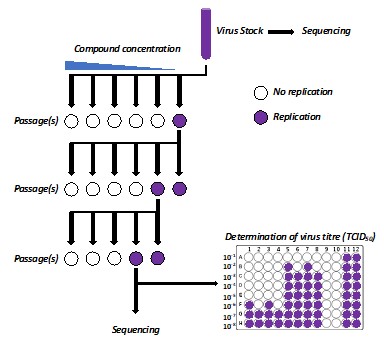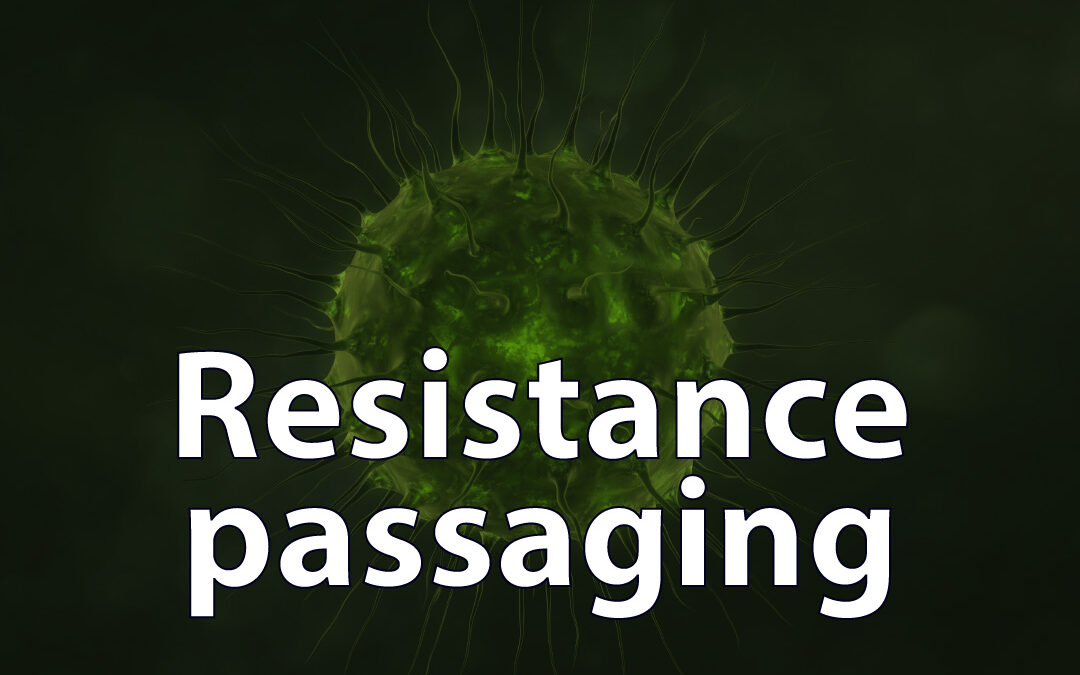What is resistance passaging? Resistance passaging is a method researchers use to investigate how microbes evolve resistance to drugs.
Why is resistance passaging useful?
Drug resistance is when a microbe overcomes a drug’s ability to kill it or prevent its proliferation. When developing a new anti-viral agent, it is prudent to know how and at what speed resistance might emerge. This advanced knowledge of how resistance is likely to develop helps with public health planning. It can also help drug developers, who might otherwise waste resources on a compound that would soon become obsolete.
HIV is often used as an example when describing the need to develop anti-viral drugs with a very high genetic barrier to resistance. HIV’s ability to rapidly acquire mutations can and has resulted in the failure of anti-retroviral therapies. In some cases, mutations giving virus resistance against one drug can also impart resistance to other drugs that share a similar mechanism of action. Ultimately, this limits treatment options for patients.
Resistance passaging and antibody therapies
Similarly, knowing how virus resistance might arise is useful when developing antibody therapies. Anti-viral antibodies can be administered to patients as monoclonals, either as a prophylactic or therapeutic agent. The efficacy of these therapies is reduced or destroyed when a virus develops resistance to the antibody. For example, monoclonal antibodies usually target a single epitope. So, any mutation in this epitope might result in resistance.
Resistance profiling and targeting multiple epitopes
If a virus develops resistance, it is useful to know what new mutations are responsible. Knowing this, combinations of monoclonals (targeting these expected new mutations or distinct epitopes) can be used from the outset. This approach forces the virus to evolve its way around multiple attacks, thus setting the genetic barrier to resistance much higher. This helps protect the long-term effectiveness of the therapy.
In vitro resistance passaging
Resistance passaging is an in vitro assay used to study how microbes might develop resistance. Resistance passaging involves growing microbes under defined conditions with an antimicrobial selective pressure at sub-inhibitory concentration(s) for multiple serial passages (Figure 1).
Viral growth can be followed using multiple methods, and if required, the amount of virus can be measured before the subsequent round of infection to ensure that each round of infection receives the same viral load. After multiple passages, the virus may acquire resistance. Such resistance can be observed by the virus growing at a higher treatment concentration than in previous rounds of passage (Figure 1).
Any virus that has acquired resistance can then be sequenced (alongside the parent virus and any controls) or put through further iterations at higher concentrations of selective pressure. Therefore, resistance passaging can determine the highest achievable level of drug resistance (depending on the number of passages*) and how fast resistance can occur. The resistant virus sequences can then be compared to the parent culture and any controls (controls, such as passaging in the absence of selective pressure, are important as viruses will always acquire mutations over time). This data helps scientists understand how the resistance was acquired.
*Treatments with high genetic barriers can require high passage numbers to develop resistance (and vice versa). This is also something that can be influenced by the virus’s mutation rate.

Figure 1. An example overview of a resistance passaging protocol.
Resistance passaging studies are often requested by regulators. At our BSL2 and BSL3 laboratories, we can test your anti-viral compounds or antibodies by first determining the IC50 of your anti-viral using our in-house anti-viral or microneutralization assay. We can then serially passage the virus of your choice in sub-inhibitory concentrations using a protocol tailored to your needs. Like this, we can report the level of resistance, how quickly resistance is achieved, and the genetic barriers to resistance.
If your research could benefit from resistance passaging testing, contact our expert team and learn how we can help.
Blog by Scott Lawrence
Edited by Reckon Better Scientific Editing




